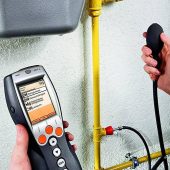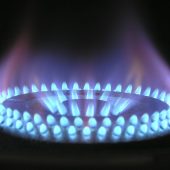Two things to keep in mind when deciding where to place a carbon monoxide detector is detection effectiveness and the ability of everyone in the house to clearly hear the alarm in case of an emergency.
Based on these requirements, the general recommendation is to place a the detector near sources of carbon monoxide such as a gas furnace and close to where family members spend most of their time such as near bedrooms.
Carbon Monoxide Placement Guidelines
Since CO is slightly less dense than air, it is logical to install the detector at a higher place (head height or higher). Ideally, an alarm should be installed in every room containing a fuel-burning appliance such as stoves, ovens, furnaces, boilers, water heaters and fireplaces.
Here are some guidelines one where exactly to install the detector.
- The detector should be close to the ceiling and higher than doors or windows.
- Ceiling-mounted alarms should be at least 30cm from any wall, while wall-mounted alarms should be at least 15cm from ceiling and between 3-1 metres horizontally away from the potential source.
- In sloping ceilings, the detector should be places at the higher end.
Additional apparatus like remote alarms may be installed to ensure adequate warning is given to occupants in other rooms where they spend most of their time awake (sitting or dining room). It is also crucial to place CO detectors as close as possible to where everyone sleeps.
If your home has multiple levels, there should be a carbon monoxide detector on every floor.
In cases where there are fuel burning appliances in more than one room but the number of detectors is limited, one can install them at these strategic positions:
- In rooms with flueless gas appliances – these are appliances lacking any pipe or chimney to exhaust gasses outside. They have a higher risk of producing dangerous levels of carbon monoxide.
- Hallways close to bedrooms – this ensures everyone hears the alarm.
- Where occupants spend most time such as the living room.
- If the premise is a bedsit (a single room serving both as sitting and bedroom) then the detector should be placed as far from cooking appliance as possible and closer to where the person sleeps.
Fixed vs. Portable Carbon Monoxide Detectors

These guidelines are applicable to detectors that are mounted in fixed locations like the Honeywell XC100D, Kidde 4MCO (hardwired), BRK Dicon CO850Mi and the First Alert CO400 models.
For hardwired models like the Kidde 4MCO (hardwired)andBRK Dicon CO850Mi, you can also link them to other remote alarms to provide sufficient warning throughout the house.
Portable detectors like the 7-year FireAngel CO detector are handy if you have multiple sources of carbon monoxide around the house.
You can carry it to the garage when working on your car, put it in the living room when you are using the fireplace or use it in any room whose CO levels you need to monitor.
Just ensure that the detector is at a vantage point and not too close to the potential source.
CO Detector Placement in Caravans
Caravans have additional risk of CO ingress through air vents from the vehicle’s engine or generators. Carbon monoxide from a close by barbeque can also get in through the vents.
This does not change the basic guidance of location of the alarm. Singled room caravans can be treated as bedsits. The alarm placed closer to sleeping area but further from cooking appliances or sinks. Any sleeping accommodation which is in a separate room from the combustion appliance(s) should also have an alarm.
Where NOT to Place a Carbon Monoxide Detector
As much as it is important to know where to correctly install carbon monoxide detectors, it is also good that you know where NOT to install them. This prevents faulty readings that may raise false alarms or damage the device.
Avoid placing a carbon monoxide detector in these areas.
- Too close to potential CO sources like gas or charcoal appliances to avoid false detection. These appliances constantly release small amounts of CO, which over time might give false information on the actual volume of CO in the room.
- In humid/moist rooms including bathrooms.
- Where dirt and dust may block the sensor.
- Directly above the sink.
- Where it can be obstructed by furniture.
- Away from where children can reach it to ensure they don’t tamper with it.
- Next to doors, windows, extractor fans, air vents or any other similar ventilation openings. The detector may not accurately detect high levels of carbon monoxide in the room, which is a safety hazard.
- In direct sunlight, as this would affect the temperature display of the detector considerably.
- Outside the house where temperatures may fall below -100 C or exceed 400 C.
- In enclosed space like inside a cupboard or behind the curtains.
Final Words
The above are just general guidelines and recommendations. Your carbon monoxide detector may come with more specific instructions on placement and operation. Make sure you read the product manual and contact the manufacturer if you have any questions or concerns. Check also our article on how to dispose of a CO detector.


